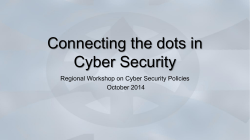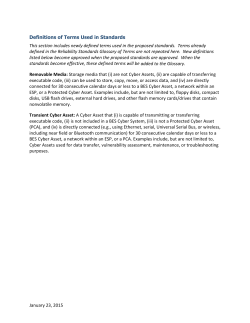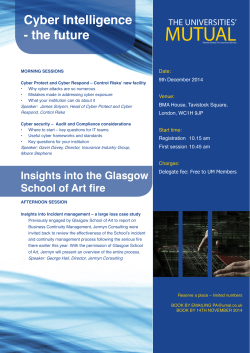
Risk nexus global cyber governance executive summary
Risk Nexus Global cyber governance: executive summary The process of globalization, the emergence of new powers, and the increasing relevance of non-state actors are creating a multipolar and interconnected world. In the international arena, political and ideological diversity among the most relevant parties, diffusion of power, and the impact of changing global economics have added complexity to the geopolitical landscape. Businesses now operate in a much more difficult, heterogeneous environment. Section 1: Emerging technologies will fundamentally change the nature of cyber risk Cyberspace has rapidly become essential to the daily life of individuals, governments and businesses. Yet with this exponential increase in activity comes the ease of use and access to data for malicious purposes. Cyber attacks are increasing in number, sophistication, scope and impact. In this context, cyber security is arguably the most salient non-traditional security issue on the global agenda. Emerging technologies such as the Internet of Things will increase the complexity of networks. Other disruptive technologies, such as unmanned aerial vehicles, additive manufacturing (such as 3-D printing), new home appliances or autonomous vehicles may also shake up established business practices and create new security threats. Cyber risks will become increasingly interconnected 1 with other global risks. Much of this evolution is already apparent. Companies in almost all sectors are exposed to cyber threats, with the potential for causing enormous damage in terms of reputation and physical losses, liabilities, and regulatory costs. Unchecked, growing cyber threats risk curtailing technical and economic development on a 2 global scale. Section 2: An inadequate global cyber governance framework Cyber attacks respect neither state nor organizational borders. A holistic and global approach to cyber governance is therefore vital. Despite some recent progress at the international and regional levels on norms and 3 confidence-building measures (CBMs) , a comprehensive and functional regime of global cyber security governance is clearly lacking. In an effort to improve the situation, we undertook a detailed mapping of the rules, institutions, and procedures that form the current global cyber 2 1 Zurich Insurance Group/Atlantic Council (2014) ‘Beyond Data Breaches: Global Interconnections of Cyber Risk,’ Risk Nexus. Available at: http://www.zurich.com/internet/ main/SiteCollectionDocuments/insight/ risk-nexus-april-2014-en.pdf World Economic Forum (2015): ‘Partnering for Cyber Resilience: Towards the Quantification of Cyber Threats’. In collaboration with Deloitte, 2015, p.9. 3 ICT for Peace, ‘Baseline Review of ICT-Related Processes and Events: Implications for International and Regional Security’, 2014, p.44. governance framework. This chapter summarizes the main conclusions of that work. An academic report containing this research in detail will be publicly available in the near future. The current global cyber governance regime can be regarded as having three layers. First, there are the more technical aspects that facilitate the proper functioning of network systems. Global governance in this area is relatively effective, and is based on a multi-stakeholder model. At the other extreme of the spectrum are cyber warfare issues such as terrorism and espionage between states, or cyber attacks on critical infrastructure for political purposes. Here, effective global governance is lacking. Between these two extremes, we find the ‘gray zone’ – a sphere where the interests of industry, governments and individuals intersect. Issues addressed in this space include net neutrality, intellectual property rights, freedom of speech, non-state or criminal cyber attacks and data protection. The ‘gray zone’ encompasses all international instruments that deal with cyber risks from a non-technical and non-military perspective. It is in this area, with its various global governance models and organizational cultures, that the international community can most effectively work to improve the current situation and facilitate the mitigation of cyber threats. Our analysis has identified two key characteristics of global cyber governance: ideological differences and geopolitical tensions preclude strong and effective global governance institutions; and the current governance framework does not adequately reflect the global nature of cyberspace. Section 3: Toward a new governance framework: challenges and opportunities Given the shortfalls in global cyber governance and the urgent need for effective risk mitigation, there are a number of recommendations that should be considered. In the absence of state consensus, we believe there is a role for the private sector to actively lobby for a set of guiding principles to overlay the global cyber governance framework. That governance should be global and inclusive in nature, based on a multi-stakeholder approach and flexible enough to adapt to rapidlyevolving challenges. The private sector should also take specific steps to mitigate cyber risk and enhance general resilience in the meantime, given the lack of effective global governance. Greater informationsharing will play a key role in developing the tools to achieve this, such as a well-functioning insurance market. For policymakers, there are a number of steps that we believe, if taken, would allow major progress toward a more effective global cyber governance framework. Recommendations include: • Strengthen ‘fit for purpose’ global institutions, which would include creating a G20 + 20 Cyber Stability Board and taking steps to isolate these institutions from geopolitical tensions. • Consider creating a cyber alert system, based on the model of the World Health Organization (WHO). • Enhance public-private cooperation, including dialogue and incentives for investment in cyber security. • Seek to increase the representation of LDCs and civil society within the global governance framework. The full Risk Nexus report is available on knowledge.zurich.com/cyberrisk/global-cyber-governance/ Disclaimer This publication has been prepared by Zurich Insurance Group Ltd and Fundacion ESADE and the opinions expressed therein are those of Zurich Insurance Group Ltd and Fundacion ESADE as of the date of writing and are subject to change without notice. This publication has been produced solely for informational purposes. The analysis contained and opinions expressed herein are based on numerous assumptions. Different assumptions could result in materially different conclusions. All information contained in this publication have been compiled and obtained from sources believed to be reliable and credible but no representation or warranty, express or implied, is made by Zurich Insurance Group Ltd or any of its subsidiaries (the ‘Zurich Group’) or Fundacion ESADE as to their accuracy or completeness. This publication is not intended to be legal, underwriting, financial, investment or any other type of professional advice. Persons requiring advice should consult an independent adviser. The Zurich Group and Fundacion ESADE disclaim any and all liability whatsoever resulting from the use of or reliance upon this publication. Certain statements in this publication are forward-looking statements, including, but not limited to, statements that are predictions of or indicate future events, trends, plans, developments or objectives. Undue reliance should not be placed on such statements because, by their nature, they are subject to known and unknown risks and uncertainties and can be affected by other factors that could cause actual results, developments and plans and objectives to differ materially from those expressed or implied in the forward-looking statements. The subject matter of this publication is also not tied to any specific insurance product nor will it ensure coverage under any insurance policy. This publication may not be reproduced either in whole, or in part, without prior written permission of Zurich Insurance Group Ltd, Mythenquai 2, 8002 Zurich, Switzerland and Fundacion ESADE, Avenida Pedralbes, 60-62, Barcelona, Spain. Zurich Insurance Group Ltd and Fundacion ESADE expressly prohibit the distribution of this publication by or to third parties for any reason. Neither the Zurich Group nor Fundacion ESADE accept liability for any loss arising from the use or distribution of this presentation. This publication is for distribution only under such circumstances as may be permitted by applicable law and regulations. This publication does not constitute an offer or an invitation for the sale or purchase of securities in any jurisdiction.
© Copyright 2025









